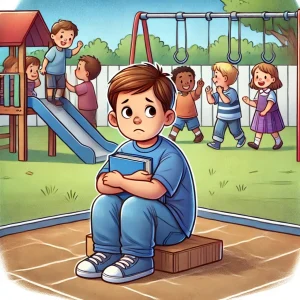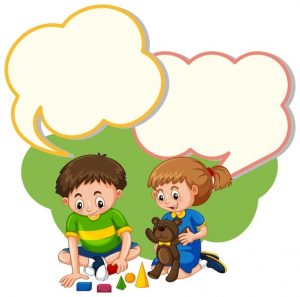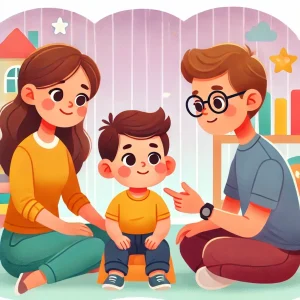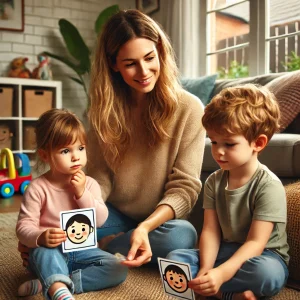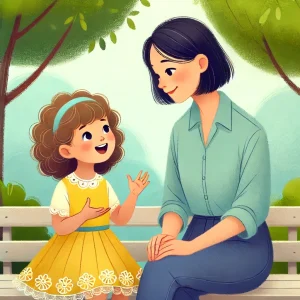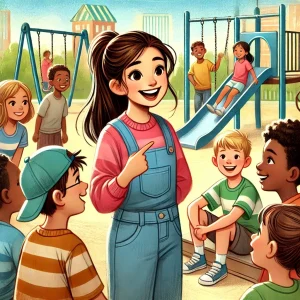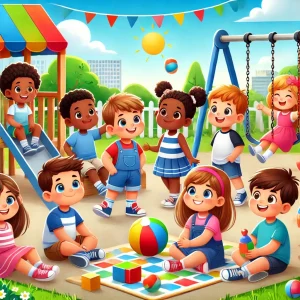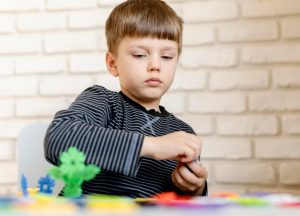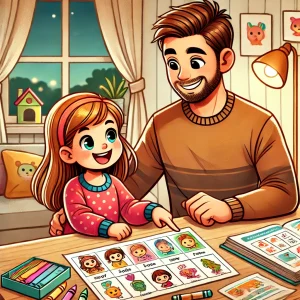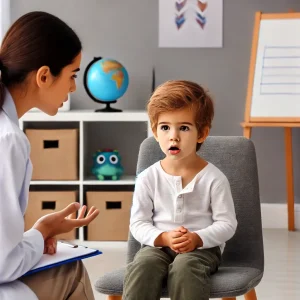Mastering Palatal Sounds in Children: A Parent’s Guide
By Rajini D
Last Updated: January 22, 2024
Palatal sounds are critical elements in language development, especially in young children. These sounds, represented by /tʃ/, /dʒ/, and /r/, play a significant role in phonetic skills acquired in early childhood. Mastery of these sounds typically occurs around the ages of 3 to 4 years old, marking a pivotal phase in speech and language skills development.
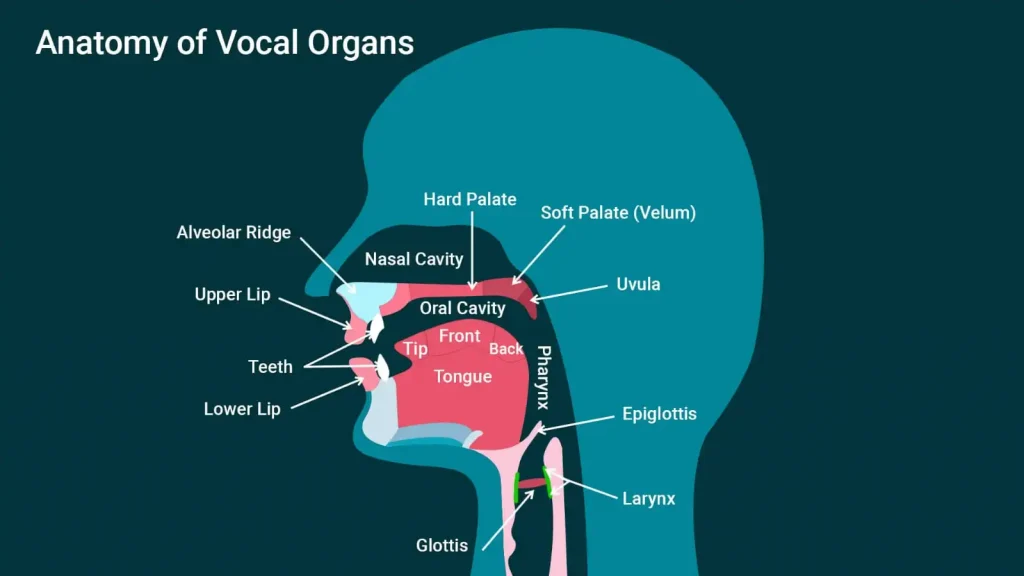
Book Free Speech Therapy Consultation.
Understanding Palatal Sounds
Defining Palatal Sounds:
Palatal sounds are produced by the tongue touching or coming close to the hard palate. These sounds are essential in many languages and are a cornerstone of early speech development. The sounds /tʃ/ (as in “chip”), /dʒ/ (as in “jug”), and /r/ (as in “rat”) are common palatal sounds, each with distinctive features:
- /tʃ/ as in “chip,” a voiceless sound where the tongue touches the palate.
- /dʒ/ as in “jug,” a voiced sound similar to /tʃ/ but with vocal cord vibration.
- /r/ as in “rat,” a sound produced by the tongue near the palate, varying in different languages.
Explore the possibilities of online speech therapy in our feature on Online Speech Therapy Redefined with Telebasics.
Techniques for Teaching Palatal Sounds
Helping children master palatal sounds can be fulfilling. Here are some effective techniques:
Technique 1: Articulation Therapy Progression
Syllables to Words:
Begin with simple syllables like “cha”, “ja”, and “ra”. Once the child is comfortable, introduce more complex syllables and words like “chair”, “judge”, and “rat”.
Words to Sentences:
After syllables, form words. This gradual progression builds confidence and understanding of how palatal sounds integrate into speech. Then, combine these words into sentences.
For more information on speech and language milestones, check out our detailed guide.
Technique 2: Tactile and Kinesthetic Cues
Physical Cues for Each Sound:
- /tʃ/ Sound: Guide the child to place their tongue towards the hard palate and release air.
- /dʒ/ Sound: Similar to /tʃ/, but with vocal cord vibration.
- /r/ Sound: Focus on the tongue’s movement near the hard palate.
Using Cues Effectively:
These cues help children understand tongue placement and breath use. Repeat regularly, guiding them through each sound’s sensations.
Also Read: Home-Based Occupational Therapy Activities.
Technique 3: Visual and Auditory Support
Visual Placement Articulation Cards:
Use cards showing tongue and lip positions for each sound. Visual aids help children understand sound production.
Auditory Repetition Exercises:
Repetition is key. Practice sounds, syllables, and words to enhance auditory memory and speech muscle coordination.
If your child is on the autism spectrum and experiencing speech delays or atypical phonological processes, learn about our Speech Therapy for Autism.
Techniques for Teaching Palatal Sounds table:
| Technique | Description | Examples |
|---|---|---|
| Articulation Therapy Progression | Gradually progressing from syllables to words and then to sentences, building a foundation for speech. | Start with syllables like ‘cha’, ‘ja’, ‘ra’, then move to words like ‘chair’, ‘judge’, ‘rat’, and eventually to sentences. |
| Tactile and Kinesthetic Cues | Using physical cues to guide the child’s tongue and lip movement enhances their understanding of sound production. | /tʃ/ Sound: Guiding tongue to palate; /dʒ/ Sound: Vocal cord vibration; /r/ Sound: Tongue movement near hard palate. |
| Visual and Auditory Support | Incorporating visual aids like articulation cards and auditory repetition exercises to improve speech muscle coordination and memory. | Using cards showing lip positions for /tʃ/, /dʒ/, /r/; Repeating sounds and words like ‘chip’, ‘jug’, ‘rat’. |
Explore our dedicated autism treatment centre in Hyderabad for comprehensive care.
Specific Practices for Each Sound
The /tʃ/ Sound
Teaching Steps
- Lip and Tongue Position: Guide the child to position their tongue correctly.
- Practice: Start with the /tʃ/ sound, then syllables like “cha”, “che”, “chi”, and words like “chip”, “cherry”, “teacher”.
The /dʒ/ Sound
Teaching Steps:
- Voice Vibration: Teach the child to feel throat vibration.
- Lip and Tongue Position: Similar to /tʃ/, but with vocal cord use.
- Contrast with /tʃ/: Demonstrate the difference between the two sounds.
The /r/ Sound
Teaching Steps:
- Tongue Position: Focus on the tongue’s movement near the hard palate.
- Practice: Start with humming, then transition to /r/ syllables like “ra”, “re”, “ri”, and words like “rat”, “ring”, “carrot”.
Specific Practices for Each Sound Table:
| Sound | Lip and Tongue Position | Practice Examples |
|---|---|---|
| /tʃ/ Sound | Position the tongue towards the hard palate and release air. | Syllables like ‘cha’, ‘che’, ‘chi’; Words like ‘chip’, ‘cherry’, ‘teacher’. |
| /dʒ/ Sound | Similar to /tʃ/ but with vocal cord vibration. | Syllables like ‘ja’, ‘je’, ‘ji’; Words like ‘jug’, ‘jelly’, ‘adjust’. |
| /r/ Sound | Focus on the tongue’s movement near the hard palate. | Syllables like ‘ra’, ‘re’, ‘ri’; Words like ‘rat’, ‘ring’, ‘carrot’. |
Discover the benefits and features of our online speech therapy services.
Advanced Practice and Word Lists
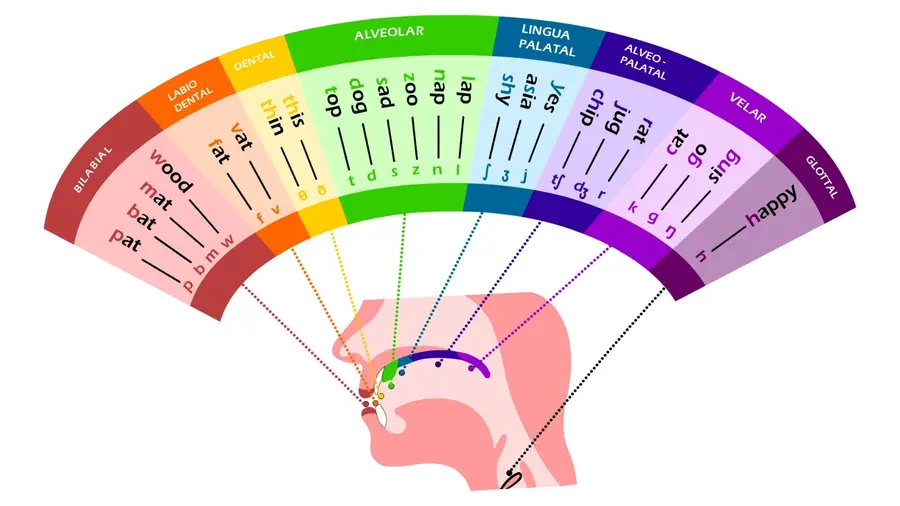
The /tʃ/ Sound
- Syllable Combinations: Practice combining /tʃ/ with various vowels – cha, che, chi, cho, chu.
- Drills: Use minimal pairs like “chat-bat”, “cheese-bees”, and “chip-dip” to distinguish /tʃ/ from other sounds.
Word List for /tʃ/ sound:
‘ch’ Sound in Initial Position of a Word
CVC Words
- ‘a’ vowel: Chat, chap, chad, chack, chasm, chap, chant
- ‘e’ vowel: Check, chess, chell, chent, chest, cheth, chew
- ‘i’ vowel: Chip, chin, chick, chill, chimp, chit, chink
- ‘o’ vowel: Chop, chon, chock, chomp, choral, chot, choke
- ‘u’ vowel: Chub, chug, chuck, chuff, chum, chug, chunk
More Complex Syllable Structures
- CVCC: Chalk, chomp, chunk, check, champ, chump, chest
- CCVC: Churn, chart, chard, choke, charm, chort, churl
- CVVC: Cheat, choo, chew, chair, choir, chute, choose
Additional Words
- Varied syllables: Chocolate, champion, charcoal, cheddar, cherish, chimney, chameleon
‘ch’ Sound in Final Position of a Word
CVC Words
- ‘a’ vowel: Bach, latch, match, patch, ratch, satch, hatch
- ‘e’ vowel: Bech, lech, mech, pech, sech, tech, fetch
- ‘i’ vowel: Bitch, hitch, kitch, litch, pitch, witch, ditch
- ‘o’ vowel: Boch, loch, moch, poch, roch, toch, cooch
- ‘u’ vowel: Buch, much, huch, luch, nuch, ruch, tuch
More Complex Syllable Structures
- CVCC: Branch, clinch, flinch, pinch, wrench, screech, starch
- CCVC: Beach, peach, reach, teach, leech, screech, breach
- CVVC: Brooch, pooch, mooch, pooch, roach, cooch, wooch
Additional Words
- Varied syllables: Outreach, approach, poach, preach, quench, search, scorch
‘ch’ Sound in Medial Position of a Word
CVC Words
- ‘a’ vowel: Archer, batcher, catcher, dacha, leach, marcher, natch
- ‘e’ vowel: Ketchup, etcher, sketcher, fetcher, lecher, richer, etch
- ‘i’ vowel: Kitchen, pitcher, ditcher, witcher, lichen, hitch, itchy
- ‘o’ vowel: Butcher, loch, poacher, roach, toucher, voucher, brooch
- ‘u’ vowel: Clutcher, butcher, dutch, much, hutch, mutch, crutch
More Complex Syllable Structures
- CVCC: Bunch, launch, punch, ranch, clinch, lynch, munch
- CCVC: Achene, echo, inch, orchid, urchin, echoic, ocher
- CVVC: Beachy, choosy, cliche, roachy, duchy, poochy, leachy
Additional Words
- Varied syllables: Orchestra, parachute, technical, sandwich, hatchet, purchase, avarice
Also read: The Crucial Role of Parents in Online Speech Therapy
The /dʒ/ Sound:
- Syllable Combinations: Combine /dʒ/ with various vowels – ja, je, ji, jo, ju.
- Drills: Use minimal pairs such as “jazz-buzz”, “jeep-beep”, “joke-yolk” to differentiate /dʒ/ from other sounds.
Word List for /dʒ/ sound:
‘ja’ Sound in Initial Position of a Word
CVC Words
- ‘a’ vowel: Jag, jam, jab, jack, jash, jad, jank
- ‘e’ vowel: Jen, jest, jell, jent, jeck, jeth, jex
- ‘i’ vowel: Jip, jin, jick, jill, jish, jint, jink
- ‘o’ vowel: Jog, jon, joll, jock, jomba, jot, joll
- ‘u’ vowel: Jun, jug, juck, juff, jusk, jull, jump
More Complex Syllable Structures
- CVCC: Jrift, jrab, jrink, jrock, jrum, jrump, jrest
- CCVC: Jwarf, jwindle, jwelt, jwest, jwrap, jrench, jroll
- CVVC: Jream, jroop, jrupe, jrain, jroid, jrew, jrool
Additional Words
- Varied syllables: Jidicate, jedimal, jecorate, jynamic, jominate, jurable, jerivate
‘ja’ Sound in Final Position of a Word
CVC Words
- ‘a’ vowel: Raj, haj, maj, taj, rajah, saj, faj
- ‘e’ vowel: Bej, lej, mej, nej, pej, sej, vej
- ‘i’ vowel: Bij, hij, kij, lij, pij, sij, wij
- ‘o’ vowel: Boj, coj, doj, goj, hoj, loj, poj
- ‘u’ vowel: Buj, cuj, huj, juj, nuj, ruj, suj
More Complex Syllable Structures
- CVCC: Adjunct, project, reject, subject, inject, deject, eject
- CCVC: Adjust, rajah, hijab, logic, magic, tragic, raj
- CVVC: Ajar, bijou, Major, mojo, dojo, jojoba, juju
Additional Words
- Varied syllables: Prejudge, nonage, adage, hostage, manage, triage, courage
‘ja’ Sound in Medial Position of a Word
CVC Words
- ‘a’ vowel: Pajama, rajah, sultan, Major, fajita, rajah, bajan
- ‘e’ vowel: Injector, rejector, projector, deject, object, eject, subject
- ‘i’ vowel: Injection, projection, rejection, bijou, Fiji, rijsttafel, hijack
- ‘o’ vowel: Jojoba, dojo, banjo, mojo, sojourner, dojo, rojo
- ‘u’ vowel: Junior, injure, conjure, adjure, perjure, junta, junco
More Complex Syllable Structures
- CVCC: Adjunct, inject, object, abject, eject, project, subject
- CCVC: Ajar, eject, inject, object, ujamaa, ajar, ojime
- CVVC: Joist, joint, rejoice, enjoy, adjoin, conjoin, rejoin
Additional Words
- Varied syllables: Adjective, injunction, projection, rejection, trajectory, juniper, juncture
Also read: What is Stuttering: Types, Symptoms, and Causes
The /r/ Sound:
- Syllable Combinations: Practice /r/ with various vowels – ra, re, ri, ro, ru.
- Drills: Practice with pairs like “rat-bat”, “red-bed”, “ride-hide” to distinguish /r/ from other sounds.
Word List for /r/ sound:
‘/r/’ Sound in Initial Position of a Word
CVC Words
- ‘a’ vowel: Rat, ran, rab, rack, rash, rad, rank
- ‘e’ vowel: Red, rest, rend, rent, reck, reth, rex
- ‘i’ vowel: Rim, rin, rick, rill, risk, rint, rink
- ‘o’ vowel: Rod, ron, rob, rock, roth, rot, roll
- ‘u’ vowel: Rut, run, rub, ruff, rush, rull, rump
More Complex Syllable Structures
- CVCC: Drift, crab, drink, rock, drum, trump, rest
- CCVC: Cramp, brink, grist, trunk, prong, throng, crust
- CVVC: Reap, roost, rune, rain, road, reed, room
Additional Words
- Varied syllables: Random, regard, result, robotic, rotate, rumble, raspberry
‘/r/’ Sound in Final Position of a Word
CVC Words
- ‘a’ vowel: Car, bar, far, jar, mar, par, tar
- ‘e’ vowel: Her, per, ser, ver, ler, fer, ker
- ‘i’ vowel: Fir, sir, bir, mir, pir, stir, whir
- ‘o’ vowel: For, bore, core, door, more, pore, sore
- ‘u’ vowel: Fur, bur, cur, pur, slur, spur, mur
More Complex Syllable Structures
- CVCC: March, birch, perch, torch, scorch, lurch, porch
- CCVC: Start, heart, burst, first, worst, throb, herb
- CVVC: Boor, pure, sure, roar, floor, your, moor
Additional Words
- Varied syllables: Answer, character, fiber, harbor, solar, upper, winter
‘/r/’ Sound in Medial Position of a Word
CVC Words
- ‘a’ vowel: Carat, tarot, farad, parapet, garish, arid, baron
- ‘e’ vowel: Peril, merit, verity, ferret, heretic, serene, beret
- ‘i’ vowel: Viral, mirage, tirade, firkin, irate, sirloin, shirr
- ‘o’ vowel: Coral, forage, storage, norad, morass, oracle, porridge
- ‘u’ vowel: Curate, turban, burrow, furrow, surmise, lurid, purr
More Complex Syllable Structures
- CVCC: Carve, marsh, birth, earth, harsh, nurse, curse
- CCVC: Ardent, urgent, orbit, ermine, irksome, orchid, artisan
- CVVC: Aerial, eerie, orion, euro, urea, area, irony
Additional Words
- Varied syllables: Barricade, corridor, hereditary, narrative, override, surprising, territorial
Read about the innovative online speech therapy redefined with Tele-Basics.
Using Books and Everyday Activities
Book Recommendations by Sound:
| Sound | Book Title | Author | Key Words |
|---|---|---|---|
| /tʃ/ | The Very Hungry Caterpillar | Eric Carle | caterpillar, crunch |
| /dʒ/ | Giraffes Can’t Dance | Giles Andreae | jungle, Gerald |
| /r/ | The Rainbow Fish | Marcus Pfister | rainbow, fish |
Incorporating Sounds into Daily Activities:
Examples of Activities:
- Play games emphasizing /tʃ/ in “Catch!”
- Use words like “jar” to highlight the /dʒ/ sound.
- During meals, focus on /r/ words like “rice” or “rabbit”.
Role in Language Development
Palatal sounds are vital in forming words and phrases, marking a key milestone in a child’s communication skills.
Continue exploring your child’s developmental journey by reading about Pediatric Therapy: Motor & Sensory Milestones.
Common Challenges
Some children may find coordinating tongue and palate movements difficult, confuse sounds, or have delayed speech development. Early intervention and speech therapy can help.
Recognizing and Overcoming Language Background Challenges
- For Spanish Speakers: Focus on differentiating /r/ sound variations.
- For Mandarin Speakers: Emphasize the distinction between the /tʃ/ and /dʒ/ sounds.
- For Hindi Speakers: Work on the retroflex /r/ sound, which is different in Hindi.
When to Seek Professional Help
Consider speech therapy for children over 3 years struggling with these sounds, showing inconsistency, frustration, or comprehension issues.
Conclusion
Mastering palatal sounds is crucial for language development. Understanding their significance, practicing with tailored techniques, and seeking professional help when needed are key steps in a child’s speech journey.
Also read: “Navigating Online Speech Therapy for Non-Verbal Children: A Guide for Parents and Educators” for a comprehensive guide on managing communication issues in children.
Frequently Asked Questions (FAQs)
1. What Are Palatal Sounds in Speech Development?
Palatal sounds, such as /tʃ/, /dʒ/, and /r/, are critical for early language development in children. They involve specific tongue and palate interactions and are essential in many languages.
2. At What Age Should Children Master Palatal Sounds?
Children typically master palatal sounds like /tʃ/, /dʒ/, and /r/ around the ages of 3 to 4 years, a crucial phase for their speech and language development.
3. How Can Parents Help Children Learn Palatal Sounds?
Parents can aid their children in mastering palatal sounds through techniques like articulation therapy progression, tactile and kinesthetic cues, and using visual and auditory support.
4. What Are Effective Techniques for Teaching the /tʃ/, /dʒ/, and /r/ Sounds?
Effective techniques include syllable practice, using physical cues to guide tongue placement and auditory repetition exercises. Additionally, contrasting similar sounds can be beneficial.
5. Why Are Palatal Sounds Important in Language Development?
Palatal sounds are fundamental for forming words and phrases, and their mastery is a key milestone in developing effective communication skills in children.
6. What Challenges Might Children Face in Mastering Palatal Sounds?
Some children may struggle with coordinating tongue and palate movements, confusing similar sounds, or delayed speech development due to difficulties with these sounds.
7. When Should Parents Seek Professional Help for Speech Development?
If a child over the age of 3 consistently struggles with palatal sounds, shows frustration in communication, or has comprehension issues, it might be advisable to seek speech therapy.
About the Author:
Rajini, Speech-Language Pathologist:
Rajini is a dedicated Speech-Language Pathologist with a focus on developmental speech and language disorders in children and rehabilitation in adults. With a passion for helping each individual find their voice, Rajini brings a wealth of experience and a heartfelt approach to therapy. At Wellness Hub, she’s part of a team that values innovation, compassion, and results-driven practices.
Book your Free Consultation Today
Parent/Caregiver Info:
Client’s Details:
* Error Message
